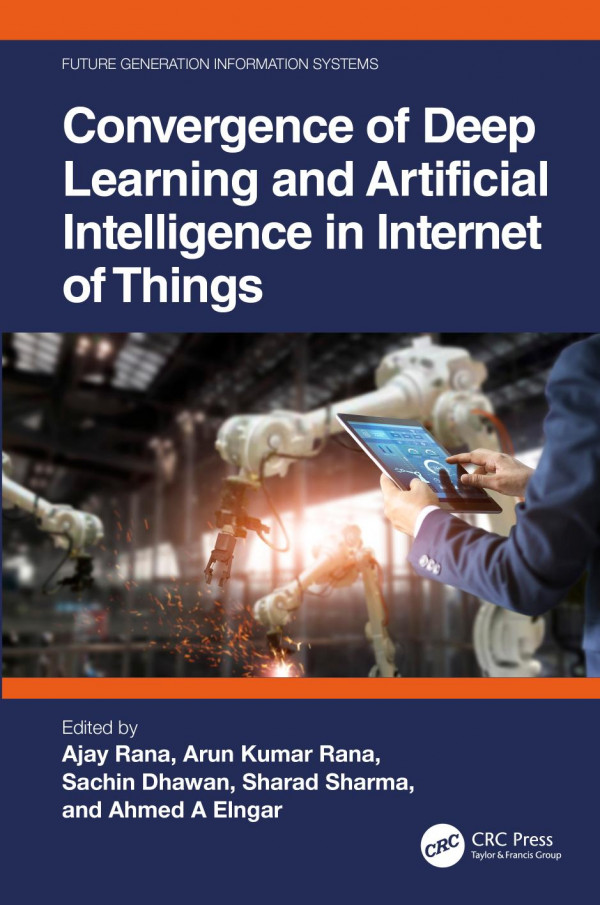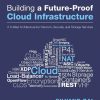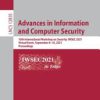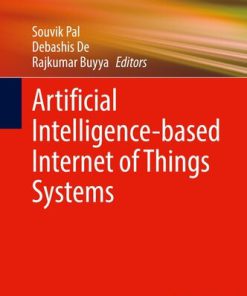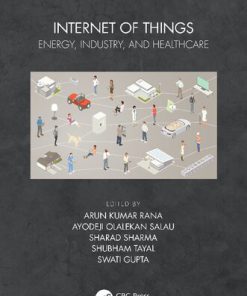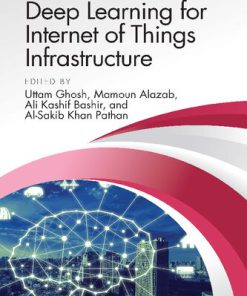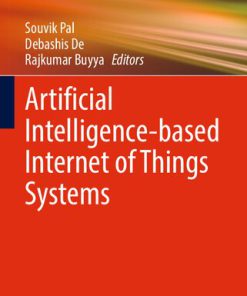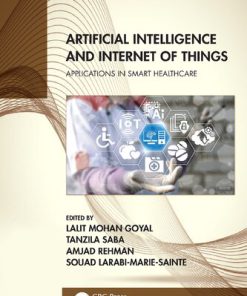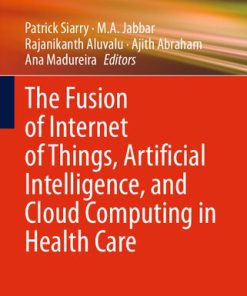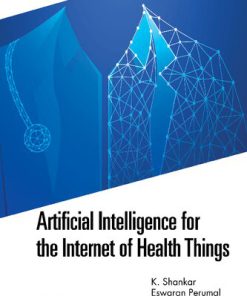Convergence of Deep Learning and Artificial Intelligence in Internet of Things 1st Edition by Ajay 9781000822090 1000822095
$50.00 Original price was: $50.00.$25.00Current price is: $25.00.
Convergence of Deep Learning and Artificial Intelligence in Internet of Things 1st Edition Ajay Rana – Ebook Instant Download/Delivery ISBN(s): 9781000822090, 1000822095
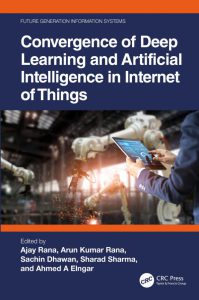
Product details:
- ISBN 10:1000822095
- ISBN 13:9781000822090
- Author: Ajay
Convergence of Deep Learning and Artificial Intelligence in Internet of Things
Table contents:
Editor Bios
List of Contributors
1 Deep Learning Algorithms for Real-Time Healthcare Monitoring Systems
1.1 Introduction
1.2 Deep Learning
1.2.1 How Does DL Function?
1.2.2 Applications of DL
1.3 DL Algorithms
1.4 Types of Algorithms Used in DL
1.4.1 Convolutional Neural Networks
1.4.2 Long Short-Term Memory Networks
1.4.3 Recurrent Neural Networks
1.4.4 Generative Adversarial Networks
1.4.5 Radial Basis Function Networks
1.4.6 Multi-Layer Perceptrons
1.4.7 Self-Organizing Maps
1.4.8 Deep Belief Networks
1.4.9 Restricted Boltzmann Machines
1.4.10 Autoencoders
1.5 Hardware Requirements of DL
1.6 Conclusion
References
2 Neural Network–Based Efficient Hybrid Control Scheme for the Tracking Control of Autonomous Underwater Vehicles
2.1 Introduction: Background
2.2 Dynamical Model Description
2.3 Error Dynamics Controller Design
2.4 Stability Analysis
2.5 Simulation Study
References
3 Integrated Storage Allocation and Privacy Preserve Deduplication Process over Cloud Using Dekey Method
3.1 Introduction
3.1.1 Cloud Computing
3.1.2 Utility Computing
3.1.3 Web Service
3.1.4 Web Service Description Language
3.1.5 Architecture of Web Services
3.1.6 Service-Oriented Architecture
3.1.7 Service Excellence
3.1.8 Service Level Agreement
3.1.9 Factors Affecting Performance Design
3.1.10 Fault-Tolerant System
3.1.11 Back Up Your Data
3.1.12 Data Streaming
3.1.13 Data from Transactions
3.1.14 Extraction of Data
3.1.15 Cloud Protection
3.1.16 Problems with Cloud Management
3.1.17 Computer Parallelism
3.1.18 Distribution of Load
3.1.19 Scheduling of Tasks
3.1.20 Model of Cloud Service
3.1.21 Cloud Deployment Model
3.1.22 Deduplication of data
3.1.23 Analytics on Big Data
3.1.24 Inspiration
3.2 Reduce Data Deduplication in Cloud Storage with an Enhanced Dekey Approach
3.2.1 Dekey Approach
3.2.2 Formulation of the Issue
3.2.3 Threat Model and Security Objectives
3.2.4 Blowfish
3.2.5 Lump Data Encryption and Decryption
3.2.6 Discussion and Conclusions
3.3 Deduplication of Data with Integrated Privacy TPA Over Cloud Storage Method
3.3.1 Formulation of the Problem
3.3.2 Work to Be Done
3.3.3 Proposed Data Deduplication with Integrated Privacy Protection
3.3.4 Regions of Data Privacy
3.3.5 Various Algorithms Are Compared
3.4 Conclusion
References
4 Internet of Things for Smart Cities: Application and Challenges
4.1 Introduction
4.2 Literature Review
4.3 IoT Benefits in Smart Cities
4.3.1 Smart Infrastructure
4.3.2 The City Air Management Tool
4.3.3 The Challenge for Huge Smart Cities Is to Optimize Traffic Flow
4.3.4 Smart Parking
4.3.5 Smart Waste Management
4.3.6 Smart Lighting
4.3.7 Crowd Sensing
4.4 Challenges for Implementation of IoT in Smart City
4.5 Conclusion
References
5 IoT-Based Garbage Monitoring System with Proposed Machine Learning Model for Smart City
5.1 Introduction
5.2 IoT Data Protocols
5.3 MQTT Protocol Working and Uses
5.4 Working Flow of MQTT-Based System
5.5 MQTT-Based System with Result
5.6 Working and How to Use ThingSpeak
5.7 Proposed Smart Solution Based on Machine Learning
5.8 Conclusion and Future Scope
References
6 Application of Natural Language Processing and IoT to Emulate Virtual Receptionist
6.1 Introduction to Virtual Assistants
6.2 Problem Statement
6.3 Objectives
6.4 Scopes and Limitation
6.5 Literature Review
6.6 Functionalities of CITY
6.7 Conclusion
References
7 An Overview: Understanding of Image Fusion
7.1 Introduction
7.2 Evolution of Image Fusion
7.2.1 Image Fusion Applications
7.2.2 Gradient-Based Fusion Performance
7.2.3 Fusion Performance Characterizations
7.2.4 Individual Sensor Contribution
7.2.5 Fusion Gain: Exclusive Information
7.2.6 Fusion Loss
7.2.7 Fusion Artefacts
7.3 Methodology
7.4 Quality Evaluation
7.5 Results
7.6 Future Trends
7.7 Conclusion
Acknowledgement
References
8 Meta-Heuristic Algorithms for Optimization
8.1 Introduction
8.1.1 Bat Algorithm
8.2 Basic Concepts
8.2.1 Pseudo Code of Bat Algorithm
8.2.2 Pseudocode of Bat Algorithm
8.3 Ant Colony Optimization
8.3.1 ACO in Brief
8.3.2 Standard ACO
8.3.3 Parameters of ACO
8.3.4 Algorithm of ACO
8.4 PSO Algorithm
8.4.1 PSO Basics
8.4.2 PSO Algorithm
8.4.3 Parameters of PSO Algorithm
8.5 Experimental Analysis
8.5.1 Dataset Description
8.6 Result Analysis
8.7 Conclusion
References
9 Internet of Medical Things Devices: A Review
9.1 Introduction
9.2 Literature Review
9.3 Various Healthcare Monitoring Sensors and Equipments
9.3.1 Arduino Uno
9.3.2 Temperature Sensor
9.3.3 Glucose Monitoring
9.3.4 Heart-Rate Monitoring
9.3.5 Depression and Mood Monitoring
9.3.6 Parkinson’s Disease Monitoring
9.3.7 Ingestible Sensors
9.3.8 Robotic Surgery
9.3.9 Liquid Crystal Displays
9.3.10 ESP8266
9.3.11 Power Supply
9.4 Software Specification
9.4.1 Arduino IDE
9.4.2 ThingSpeak (API)
9.5 Conclusion and Future Work
References
10 COVID-19 Patient Remote Health Monitoring System Using IoT
10.1 Introduction
10.2 Methodology and Implementation
10.2.1 Acquiring PPG Signal – HR, HRV, tHb, SpO2
10.2.2 Piezoelectric Sensors – RR
10.2.3 Sensor LM35 – Temperature
10.2.4 Global Positioning System (GPS) Module – Location
10.2.5 ThingSpeak for COVID-19 Patient Remote Monitoring
10.3 Software Implementation of System
10.4 Result and Discussion
10.4.1 Bland–Altman Analysis
10.4.2 Regression Analysis
10.4.3 Accuracy of the System
10.4.4 Monitoring Parameters over IoT Server
10.5 Conclusion
Funding Source
Ethical approval
Availability of data and material (data transparency)
Code availability (software application or custom code)
References
11 Prediction of Alanine Using Neural Network Model
11.1 Introduction
11.2 Methodology
11.3 Experimental Setup
11.4 Sample Preparation
11.5 Development of the PCA–ANN Model
11.6 Prediction Using PCA–ANN Model
11.7 Validation
11.8 Conclusion
References
12 Hybrid Algorithm for Detection of COVID-19 Using CNN and SVM
12.1 Introduction
12.2 Literature Survey
12.3 Proposed Method and Algorithm (Figure 12.1)
12.3.1 System Architecture
12.3.2 Dataset
12.3.3 Pre-processing (Figure 12.2)
12.3.4 Data Augmentation
12.3.5 Convolution Neural Network (Figure 12.4)
12.3.6 SVM Classifier (Figure 12.5)
12.4 Result and Analysis
12.5 Conclusion
References
13 Deep Learning Algorithms for IoT-Based Hybrid Sensor Using Big Data Analytics
13.1 Introduction
13.2 IoT Sensor Observe System
13.3 Big Data Dispensation
13.4 AI Methods in Manufacturing
13.5 Methodology
13.5.1 System Design
13.5.2 IoT Sensor Data
13.5.3 IoT with Big data
13.5.4 Big Data with Hybrid Sensor Network
13.6 Implementation
13.6.1 Half-and-Half Prediction Model for Fault Detection
13.7 Results and Discussions
13.7.1 IoT-based Sensor Execution
13.7.2 Big Data Processing Performances
13.7.3 Hybrid Fault Prediction Model
13.8 Conclusion
References
14 Delineation of Landslide Hazard Zones of a Part of Sutlej Basin in Himachal Pradesh Through Frequency Ratio Model
14.1 Introduction
14.2 Materials and Methods
14.3 Results and Discussions
14.3.1 Analysis of General Physical Parameters of the Study Area
14.3.2 Elevation
14.3.3 Geology
14.3.4 Geomorphology
14.3.5 Slope
14.3.6 Analysis of Drainage and Morphometric Properties of the Study Area
14.3.7 Analysis of Land Use and Land Cover of the Study Area
14.3.8 Analysis of Rainfall Scenario of the Study Area
14.3.9 Analysis of NDVI of the Study Area
14.3.10 Appraisal of Landslide Susceptibility of a Part of Sutlej Basin
14.3.11 Validating the Model
14.3.12 Role of Vegetation to PreventLandslides
14.4 Conclusion
References
15 Crop Recommendation System Using Machine Learning Algorithms
15.1 Introduction
15.1.1 Motivation
15.1.2 Problem Statement
15.1.3 Objectives
15.2 Related Work
15.3 Methodology
15.3.1 Data Analysis
15.3.2 Data Processing
15.3.3 Training Model and Crop Recommendation
15.4 Xboost Algorithm
15.4.1 Algorithm Demonstration
15.5 Experimental and Performance Matrix
15.5.1 Experimental Setup
15.5.2 Dataset
15.6 Experimental Results
15.6.1 Exploratory Data Analysis
15.6.2 Classification Algorithm Accuracy Comparison
15.8 Conclusion
References
16 Impacts of Artificial Intelligence, Deep Learning, and Internet of Things
16.1 Introduction
16.2 Literature Review
16.3 Advantages of AI, DL, and IoT
16.4 Limitations of AI, DL, and IoT
16.5 Applications of AI, DL, and IoT in Daily Life
16.6 Future Perspectives of AI, DL, and IoT
16.7 Conclusion
References
17 A Support Vector Machine–Based Deep Learning Approach for Object Detection
17.1 Introduction
17.2 Literature
17.3 Proposed Methods
17.4 Results
17.5 Conclusion
References
18 Artificial Intelligence and IOT-Based Electric Grid: Future of Micro Grid
18.1 Introduction
18.2 Modelling of AI-Based Electric Grid
18.2.1 Features of Smart Grid
18.2.2 AI and Its Application to Smart Grid
18.3 Application of IOTs in Electric Grid
18.3.1 Design of IoT-Based Smart Grid
18.4 Conclusion
References
19 An Analysis of Artificial Intelligence Initiatives and Programmes in India
19.1 Introduction
19.2 Artificial Intelligence (AI)
19.3 Artificial Intelligence in India
19.4 National Strategy on AI 2018
19.5 AI for All Initiatives
19.6 AI Gamechangers Program
19.7 AI Academic Institutions and Centres in India
19.8 State of AI in India 2021
19.9 75 & 75 India’s AI Journey
19.10 Responsible AI #AIFORALL
19.11 Conclusion
References
20 A Vital Fusion of Internet of Medical Things and Blockchain to Transform Data Privacy and Security
20.1 Introduction
20.2 Related Work
20.2.1 Internet of Medical Things
20.2.2 Verification and Approval Technique for IoMT
20.2.3 Privacy Preserving Approaches for IoMT
20.2.4 Decentralized Access Control
20.3 Safety and Confidentiality Necessities for IoMT
20.3.1 Data Level
20.3.2 Sensor Level
20.3.3 Medical Server Level
20.4 Role of Blockchain Technology in IoMT Security
20.5 Conclusion
References
Index
People also search:
convergence of deep learning and artificial intelligence
deep learning ai examples
convergence artificial intelligence
convergence artificial intelligence and quantum computing
convergence ai
You may also like…
Computers - Networking
Internet of Things Artificial Intelligence and Blockchain Technology R.Lakshmana Kumar (Editor)
Computers - Artificial Intelligence (AI)
Artificial Intelligence based Internet of Things Systems Souvik Pal (Editor)
Computers - Hardware
Internet of Things: Energy, Industry, and Healthcare 1st Edition Arun Kumar Rana (Editor)
Computers - Computer Science
Deep Learning for Internet of Things Infrastructure 1st Edition Uttam Ghosh
Computers - Artificial Intelligence (AI)
Artificial Intelligence-based Internet of Things Systems First Edition Souvik Pal (Editor)

